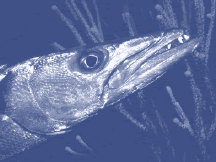|
|
Some Sea Creatures to Think Twice About
For anglers, swimmers or anyone who ventures on the sea, dangerous marine animals divide into three broad types: biters, stingers, and poisoners. Among the biters, sharks are the ones with the longest rap sheet. And even though the human race has always been thousands of times more dangerous to sharks than vice versa, in many cases they deserve their notoriety. Makos, for one of the best examples, are now classified as a game fish and are widely harvested for their food value - but they are also fast, savage and can be extremely dangerous, with a long history of attacks on people and even on boats. Found in warm waters of the Atlantic, in the summer they are reported as far north as the Canadian Maritimes, and variations of the species range the whole Pacific. Growing to 13', they have prominent teeth, slender shapes, and stealth colors: blue-gray or deep blue when viewed from above, with a white belly to reduce visibility from below. The Tiger Shark is at least as ubiquitous in all the world's warm oceans, and is the most common species in the tropics. Easily recognized by its short snout and sharply pointed tail, it usually outgrows the striping from which it derives its name; adult Tigers, up to 20' long, are gray or grayish brown, darker toward the dorsal. Primarily scavengers, they can be fast in a chase but are generally more sluggish than the Mako and somewhat less inclined to human attacks. Hammerheads are probably the most striking in appearance of the dangerous varieties, with their futuristic/primeval design featuring a wing-like, cantilevered skull terminating at each end in a black and yellow eye. Fast, powerful and up to 15' long, they have been known to attack swimmers and small boats. The favored cinematic heavies of the shark world are the Great Whites, thanks to the movie Jaws and with a boost from reports in the press some years ago that one of them ate the Prime Minister of Australia. They deserve their reputations. Aggressive, fast, with lethal triangular teeth and a history of boat attacks, at a length of 15' they can weigh more than a ton and a half. Other noted biters include the Orca (or less fashionably the Killer Whale) which, Free Willie notwithstanding, has been known to lunge right up onto the shore in pursuit of warm-blooded prey and is rightly regarded as one of the most dangerous animals on earth. The Moray eel - another Benchley subject, after the Great White - can grow to 10', has an extremely destructive, tearing bite, and is easily provoked to attack, especially in response to blind probes by divers or to offers of finger food (pun intended.) And no list would be complete without the ubiquitous barracuda, a school fish designed like a mackerel with serious overbite, growing up to 8' but less than half that length on average, some species of which are considered more dangerous than the average shark. Did you know that the shy, reclusive octopus is a biter as well? But it has more in common with the stonefish or the sea snake than with the sharks: its bite is poisonous. The characteristic two small punctures can cause extensive bleeding from the anti-coagulant in its venom, and the wound soon becomes swollen, inflamed and hot. There is no treatment for the bleeding other than to staunch the flow and wait for the venom to wash out of the system. Other poisonous sea creatures are: cone shells - snails whose venom can produce paralysis and even death; sea snakes - true air-breathing snakes capable of staying submerged in the ocean for hours and whose venom can be several times more deadly than a rattler; a wide variety of jellyfish, most notably the sea wasp and Portuguese Man of War; the spiny sea urchin; and a host of toxic teleosts that range from catfish, toadfish, weever fish, scorpionfish, and stingrays all the way to the Zebrafish. And just when you thought it was
safe to go into the water again! Well, that's the point of this
list. If you know what to watch out for and have the common sense
to avoid unnecessary risk, boating is safer than ever.
|
|
|||

